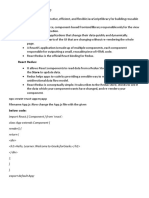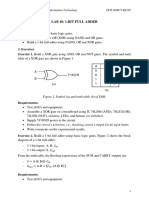0% found this document useful (0 votes)
18 views6 pagesUnit-2 Fs Comprehensive Notes
The document provides an overview of React, a JavaScript library for building user interfaces, detailing its core concepts such as component-based architecture, declarative UI, and the virtual DOM. It also explains how to set up a React project using Create React App, the role of ReactDOM, and the use of JSX for writing HTML-like code in JavaScript. Additionally, it covers React elements, components, and the process of rendering elements to the DOM, using various analogies for better understanding.
Uploaded by
ayush05deoCopyright
© © All Rights Reserved
We take content rights seriously. If you suspect this is your content, claim it here.
Available Formats
Download as PDF, TXT or read online on Scribd
0% found this document useful (0 votes)
18 views6 pagesUnit-2 Fs Comprehensive Notes
The document provides an overview of React, a JavaScript library for building user interfaces, detailing its core concepts such as component-based architecture, declarative UI, and the virtual DOM. It also explains how to set up a React project using Create React App, the role of ReactDOM, and the use of JSX for writing HTML-like code in JavaScript. Additionally, it covers React elements, components, and the process of rendering elements to the DOM, using various analogies for better understanding.
Uploaded by
ayush05deoCopyright
© © All Rights Reserved
We take content rights seriously. If you suspect this is your content, claim it here.
Available Formats
Download as PDF, TXT or read online on Scribd
/ 6























































































